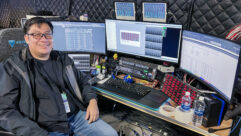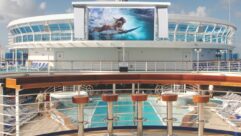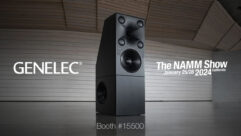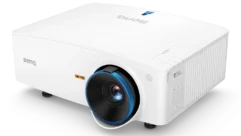
Installation Profile: High-tech Hotspot
Feb 1, 2008 12:00 PM,
By Allen DeRilke
Trendy nightclub installs latest AV wizardry.

Every aspect of Philadelphia club G combines to immerse guests in an atmosphere of high-tech elegance, including an LED wall created by Element Labs that provides an ever-present, ever-changing backdrop visible from most zones in the club.
Like many urban downtowns, inner-city Philadelphia has been undergoing a renaissance of late. Crumbling warehouses emerge from their construction cocoons sporting wings of modern condo loft apartments for a growing influx of young working professionals. The once-deserted evening streets buzz with nightlife — the area’s denizens ever on the lookout for the latest in trendy eateries and clubs.
G, the newest hotspot to hit downtown Philly, is an upscale lounge and restaurant located at the corner of 17th Street and Chestnut, in the city’s fashionable Rittenhouse Square neighborhood. Billed as “technologically injected pure bliss,” the venue occupies the once-dormant basement of Club Quarters, an exclusive corporate hotel chain with locations in London and several U.S. cities. Although it’s not officially a historical landmark, the hotel’s Colonial Revival-style building dates back to 1927. Its 10,000-square-foot basement was gutted to its stone walls to make way for the club.
The concept behind G is one of high-tech elegance. The stark, sleek, black-and-white décor serves as a subtle backdrop to offset the chrome and Plexiglas accents. The venue’s long sight lines and open architecture emphasize a spaciousness that can be visually manipulated and subdivided using different lighting accents. Cleverly implemented acoustic blocking — along with multizoned audio, video, and lighting systems — creates a flexible environment that can function as several neighboring zones or be grouped together to create one or several larger party and performance areas. Depending on which night you go to G, and where you sit, the club can seem like many different places.
“Our ultimate objective was to create a flexible space that could be manipulated using lighting, video, and audio room combining to create a multitude of different scenarios,” says Adam Freemer, systems engineer for Broomall, Pa.-based Audio Video Systems Group (AVSG), the company behind the media-systems design at G. “We can create up to 15 individual zones [12 zones in the main area, plus three for the DJs], each of which can access any of several audio and video feeds.”
Freemer worked with the club’s owner, Mark Marek, to create a concept that combined the best aspects of various clubs Marek had visited.

A Zen garden-inspired indoor waterfall greets guests with a serene rippling effect.
WATCHING THE WALLS
Eye candy is a big part of the G experience, and it begins in the club’s entryway — where a large, Zen garden-inspired indoor waterfall ushers in arriving guests with a serene rippling effect. Nearby, behind a smoked Plexiglas wall, three Raxxess 44RU equipment racks filled with audio, video, and switching gear glow with a warm, high-tech aura.
Inside the club, most of the main area’s rear wall is home to a uniquely designed, 55ft. LED wall that creates both a signature focal point visible from much of the club and a constantly morphing background atmosphere. Austin, Texas-based Element Labs created the Versa TILE display, one of the largest LED walls of its kind.
Several hundred 5in. Versa TILE LED panels, each capable of producing more than one billion colors, create the effect of electric wallpaper. The proprietary controller that feeds this display can project QuickTime movies formatted to implement the display’s panels as oversized pixels, or it can display custom visual applications include a fully functional audio-meter display or abstract, pulsating patterns.
Several more-traditional LCD screens also line the walls, including a 65in. Sharp Aquos LC-65D93U, two 52in. LG Electronics 52LB5D screens, and three 42in. LG 42LC7D screens covering the lounge and dance-floor areas and a pair of LG 37in. 37LC7D screens residing at either end of the cigar bar. An Extron Electronics 60-325-16 8×8 wideband matrix switcher handles routing video signals over Cat-5 to eight Extron DVS 304 video scalers that optimize the video sources for the HD displays. Video sources include two Sony SLV-D380P DVD/VCR players, PC video, and a high-definition cable TV feed.
Installation Profile: High-tech Hotspot
Feb 1, 2008 12:00 PM,
By Allen DeRilke
Trendy nightclub installs latest AV wizardry.

The club’s two DJ booths are impressively outfitted for top-notch sound.
BIG SOUND, GOOD LOOKS
Audio for the club’s main area is based around a combination of four Community Professional iBOX iHP1596 flown 15in. cabinets, along with EAW tweeter arrays and custom-built, 18in. horn-loaded subwoofers created by Craig Barnabeau of East Brunswick, N.J.-based Systems by Shorty (SBS).
“One challenge at G was the low ceiling height,” Freemer says. “One of the great features of the Community iBOX loudspeakers is their rotatable horns. This made them ideal for the main dance area, allowing me to mount them horizontally without compromising the dispersion pattern.”
A second challenge, Freemer says, was achieving a strong high-frequency response. “Normally, we would address this with tweeter arrays, but because of the low ceilings, we ended up mounting them in the dropped ceiling, cut right into the ceiling tiles.”
Although the main dance floor at G is somewhat compact, it was important to achieve a high-impact, well-rounded sound. Not surprisingly, aesthetics figured large in the system design as well, and Freemer responded with four custom-built, 18in. horn-loaded subwoofers from SBS.
“In nightclub applications, I prefer the sound of horn-loaded subs over front-loaded designs, and the small footprint and high efficiency of the SBS subs made them ideal for this application,” he says. Two of the subs are built into the DJ booth, with the other two stacked vertically on the opposite side of the main dance floor, creating a nice sweet spot in the center. Eight Community VERIS 8 wall-mounted 8in. systems and 12 flown VERIS 12-96 12in. two-way boxes surround the main dance floor.
“One of my goals for that area was a smooth-sounding fill, rather than an obtrusive ‘in-your-face’ kind of sound,” Freemer says. “I EQed these areas to be especially soft in the vocal and mid-range areas so the bartenders and staff could function without having to yell over the music, yet have enough sound to make these areas comfortably engaging to the patrons.”

The ultra-exclusive Mogul Room, isolated in a former vault, invites VIPs with an environment all its own.
The LED wall faces a raised area that forms the three VIP zones, which are covered by 6in. ceiling loudspeakers for unobtrusive fill, augmented by two Community SBS-12 subwoofers.
“We crossed the ceiling speakers over at an exceptionally high frequency, nearly eliminating all low-end content,” Freemer says. “The goal was to provide some background fill and get the ‘oomph’ from the subs built into the walls.”
One of the building’s more interesting architectural features is the Mogul Room, an ultra-private area fashioned out of a former vault. With its massive steel-vault doors and 3ft.-thick reinforced walls, the area is more than just soundproofed.
“Needless to say, the Mogul Room is its own world, both environmentally and acoustically speaking,” Freemer says. Two more VERIS 8 wall-mounted systems and another pair of SBS-12 subs cover the area, creating a warm, subdued, and very exclusive atmosphere without being overly intrusive.
Two SBS Audio Thrive Maya bipolar/Mosfet hybrid amplifiers outputting close to 3000W per channel drive the four Community iBOX loudspeakers and four SBS subwoofers in the two dance-floor areas, while one Thrive Alba Class A/B Mosfet model powers the two EAW DCT1 tweeter arrays. Crown CTs-series amplifiers power the remaining zones and DJ booths.
CREATIVE SIGNAL ROUTING
Club staff can select the audio source for each of the lounge’s separate zones using one of 12 corresponding Rane SR4 remote-source and volume-selector controls, allowing any potential configuration of zones and room combining. As Freemer explains, the system was — at least in part — born out of a need for simplicity.
“The original proposal had included touchscreen controls in every area and a far more complex zoning scenario,” he says. “But as we went through our planning discussions, it became clear that ease of operation was a high priority since there would potentially be numerous people with varying levels of technical expertise operating the system. … This way, the end user only has to deal with a single rotary controller. Anyone can operate it.”
The equipment-room racks house all the SR4 remote-source controllers, making it possible to quickly reconfigure the audio source for any zone from a single, central location. “Ultimately, we ended up with a far more simple system than we’d originally planned for, and we ended up saving them quite a bit on their budget besides,” Freemer says.
One of the more innovative aspects of the system’s design is in the actual routing implementation, a scheme employing four Rane RPM 88 matrix DSP units. Although Rane does not promote the RPM series as scalable, per se, Freemer used the devices’ AES3 I/O to share signals across three of the units and achieve control over 12 zones.
“The premise behind the design was that the venue’s main configuration is as a single zone, with the source being the primary DJ booth,” he says. “We wanted to keep the primary DJ booth’s audio signal path as clean as possible, so it made sense to route this signal digitally across the three RPM 88s that output to the 12 independent zones.” Secondary sources, such as DVD and CATV audio, are routed to each processor via the analog inputs. A single RPM 88 unit is dedicated exclusively to processing for the DJ booths, providing equalization, dynamics, and crossover duties. A dedicated discrete output synchronizes the display to the music.

Audio is designed and controlled for patron and staff comfort in all of the club’s 12 zones. Community VERIS loudspeakers surrounding the dance floor are smooth-sounding and EQed to be comfortably engaging rather than overpowering in the lounge’s bar zone.
A BETTER SPIN ON IT
Since opening its doors, G has quickly established a reputation as one of the city’s most popular performance venues, hosting a string of guest DJs from across the United States and abroad. Particular attention has been paid to the club’s DJ facilities.
Each of the two DJ stations is outfitted with Panasonic Technics SL-1200MKII turntables and Pioneer CDJ-1000MKIII CD players, along with Rane MP 2016a DJ mixers and XP 2016a expansion units, all housed in custom-designed consoles.
DJs carting their own laptops can take full advantage of the booths’ Rane Serato Scratch Live integration via custom Switchcraft patch bays. The patch bays also allow for connection of a secondary mixer, providing flexibility for guest DJs and the ability to connect a live soundboard directly into the system without having to remove the primary DJ mixer.
The two DJ booths each use a pair of Community VERIS 12-96 cabinets and a single VERIS 212S dual 12in. subwoofer for monitoring.
“DJ booths are probably one of the most overlooked areas for good monitoring, and I wanted things done properly at G,” Freemer says.
The primary booth’s turntables sport a custom suspension system, which eliminates feedback and vibration from the booth’s subwoofer and main dance-floor subwoofers — all of which sit directly underneath the console.
Freemer says that one of his own favorite features is the system’s SBS three-way DJ crossover — modeled after the classic RLA crossover, a design that is much sought-after in nightclub installations. “SBS has created what I think is one of the best modern alternatives to the classic RLA crossover. Because the main dance-floor system has so much power behind it, having the ability to adjust the different frequency-range levels independently from the booth is a great feature,” Freemer says.
Freemer also admits to being a fan of analog processing. “The Community iBOX cabinets use the Rane DSP for high- and low-pass filtering, but the subwoofer and super-tweeter crossovers are exclusively in the analog domain.”
BRINGING THEM IN THE DOOR
As most urban dwellers know, the rebirth and rebuilding of a city’s downtown areas can be a long and sometimes slow process. Those few brave souls who choose to be among the first to take up residence in blighted, run-down neighborhoods are typically individuals whose creativity, vision, and courage exceed their financial means.
But it is those forward-thinking urban pioneers who breathe the first flush of new life into forgotten urban pockets. In Philadelphia’s historic downtown, the success of clubs such as G is testament to the area’s reawakening, and the lines of well-dressed guests queuing nightly for entry illustrates what a forward-looking AV design and installation project can do for such facilities.
For More Information
Community Professional
www.communitypro.com
Crown
www.crownaudio.com
Element Labs
www.elementlabs.com
Extron Electronics
www.extron.com
LG Electronics
us.lge.com
Panasonic Technics
www.panasonic.com/consumer_electronics/technics_dj/flash.asp
Pioneer Electronics
www.pioneerelectronics.com
Rane
www.rane.com
Raxxess
www.raxxess.com
Systems by Shorty
www.systemsbyshorty.com
Sharp
www.sharpusa.com
Shure
www.shure.com
Switchcraft
www.switchcraft.com










